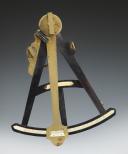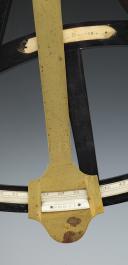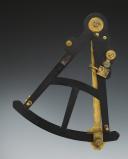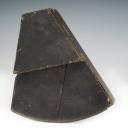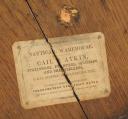
MARINE OCTANT in Hadley style, 1790-1810, First third of the 19th century. 30391.
Sold out
MARINE OCTANT, Hadley style, 1790-1810, Early 19th century. 30391
Large octant signed "F. KROG. BERGEN" in mahogany, bone, and boxwood, with 2 sights and 1 set of 2 movable filters, without a handle for holding the instrument, which will be provided later.
A major advancement in maritime history, the octant is used to "take a fix" during navigation without any terrestrial landmarks. It is used to measure angular distances between two points. The most common use is to take vertical readings, by reflection, of the altitude of a celestial body above the horizon. It is mostly used to calculate the height of the sun at noon. The octant was invented simultaneously by American optician Thomas Godfrey (1704-1749) around 1730 and British astronomer John Hadley (1682-1744) in 1731. It has an angular opening of 45 degrees, which is 1/8 of 360 degrees (hence the name "octant"). The limb is graduated, here on bone, from 0 to 90 degrees (corresponding to the maximum altitude of the celestial body below the horizon). Its operation involves aligning, using movable mirrors, the image of the observed object and the horizon on top of each other for the observer, then measuring on the limb the angle required for this alignment, which corresponds to the precise height of the celestial body above the horizon.
Presented in its black-painted wooden case, interior with a paper label printed in black "NOTICAL WAREHOUSE CAIL & ATKIN STATIONERS PRINTERS, OPTICIANS AND CHARTSELLERS 43 & QUAYSIDE NEW CASTLE UNION TILE".
Great Britain.
Early 19th century.
Good condition, small chip on one bone plate. Case cracked on the lid, one hinge broken, as well as the lock entrance, key missing.
Large octant signed "F. KROG. BERGEN" in mahogany, bone, and boxwood, with 2 sights and 1 set of 2 movable filters, without a handle for holding the instrument, which will be provided later.
A major advancement in maritime history, the octant is used to "take a fix" during navigation without any terrestrial landmarks. It is used to measure angular distances between two points. The most common use is to take vertical readings, by reflection, of the altitude of a celestial body above the horizon. It is mostly used to calculate the height of the sun at noon. The octant was invented simultaneously by American optician Thomas Godfrey (1704-1749) around 1730 and British astronomer John Hadley (1682-1744) in 1731. It has an angular opening of 45 degrees, which is 1/8 of 360 degrees (hence the name "octant"). The limb is graduated, here on bone, from 0 to 90 degrees (corresponding to the maximum altitude of the celestial body below the horizon). Its operation involves aligning, using movable mirrors, the image of the observed object and the horizon on top of each other for the observer, then measuring on the limb the angle required for this alignment, which corresponds to the precise height of the celestial body above the horizon.
Presented in its black-painted wooden case, interior with a paper label printed in black "NOTICAL WAREHOUSE CAIL & ATKIN STATIONERS PRINTERS, OPTICIANS AND CHARTSELLERS 43 & QUAYSIDE NEW CASTLE UNION TILE".
Great Britain.
Early 19th century.
Good condition, small chip on one bone plate. Case cracked on the lid, one hinge broken, as well as the lock entrance, key missing.
Reference :
30391
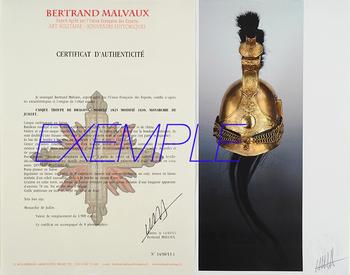
Next update Friday, april 4th at 1:30 PM
FOR ALL PURCHASES, PAYMENT IN MULTIPLE CHECKS POSSIBLE
bertrand.malvaux@wanadoo.fr 06 07 75 74 63
An authenticity certificate of the item including the description published on the site, the period, the sale price, accompanied by one or more color photographs is automatically provided for any item priced over 130 euros. Below this price, each certificate is charged 5 euros.
Only items sold by me are subject to an authenticity certificate, I do not provide any expert reports for items sold by third parties (colleagues or collectors).
